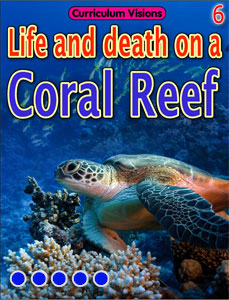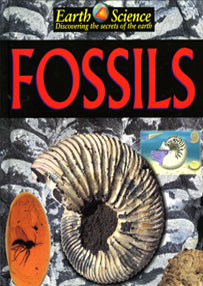Everyone knows about corals and reefs – or do they? For example, did you know that reefs live on just one per cent of
the world’s oceans and that, even so, they are still home to a quarter of the world’s ocean species?
Did you know that corals are alive, yet made of stone? That they live with even tinier living things – called algae – inside them? And that corals are not coloured at all – it’s these tiny algae inside them that give the colour?
The word reef comes from the old Viking ‘rif’, which means a rib – an undersea danger to ships.
When European sailors first arrived at shores surrounded by coral reefs, they were very aware that the sharp corals could tear the bottoms of their small boats. In time, therefore, the word rif became changed to reef, and coral reef became the name for a dangerous shallow area made of corals. However, coral reefs are not just made of corals, but also of little algae, which also make a limy mud. So it is two kinds of tiny living things that build reefs together.
Corals are tiny, very simple animals whose bodies are usually just a few millimetres across and which belong to the same group of living things as jellyfish and sea anemones. As you will know, jellyfish and sea anemones have soft bodies. Some corals have soft bodies, too. But there is one kind (called the stony coral) that makes a rocky tube as a home, and that is the kind that makes reefs.
Curiously, corals are among the oldest living things – they can be found as some of the earliest fossils – and yet they have not really changed (evolved) much at all since that time.
It’s easy to get the wrong impression about corals. Some of the corals often look dead because the tentacles of the animals have retreated within their limestone shells. But when they expand from their shells – and that happens mostly at night – you can see that each polyp has a ring of tentacles surrounding a central ‘mouth’. Now the reef has come alive.
Some kinds of tentacles are thick and stumpy, other kinds are long and wavy. But whatever the shape, each tentacle is fringed with tiny stinging hairs. Their job is to catch tiny pieces of food, such as plankton and fish larvae, and stun them before pushing them towards the mouth.
Reef-building corals
There are about one thousand species of coral, which build different shapes such as wrinkled brains, cabbages, table tops, stag antlers, wire strands, plates and pillars.
Coral reefs are a sort of scaffolding covered in tiny houses. Reefs are made of countless billions of sea animals and plants that make limestone skeletons. Each skeleton is a tube, and it is used as a kind of shell, to protect the soft body of the animal from being eaten. Corals mainly grow by producing buds – tiny little copies of themselves – which attach to their parent using lime that they make in their tissues. As a result, most corals grow on top of one another in dense colonies. But each one has to get food, and so it must reach out into the water. This is why many of the corals have branching shapes or long parallel plates. Each branch allows as many corals as possible to stand out in the water and catch its food.
As each new generation fastens itself to the remains of its dead ancestor’s skeleton, coral reefs can become huge. In fact, they have made some of the most important rocks throughout the Earth’s history.
Corals can live alone, but usually they don’t. Instead, they live with tiny algae living in their ‘skins’. Once the coral has digested its food, it gives out its waste in the form of nitrogen and carbon dioxide – just the stuff the algae need to live on. The algae work in reverse. When they have finished making new tissues, they give out oxygen and nutrients – just what the coral needs. So, in general, coral and algae, live happily together, each helping the other survive.
The other thing the algae do for the corals is to give them some of their colour. Corals have little colour themselves, and their skeletons are simply the white colour of limestone. But algae are all coloured, just, for example, as the leaves of land plants are coloured. So all the reds and yellows, pinks and oranges, blues and tans, are all colours given by the algae that live in the skin of the coral.
The algae benefit from a safe environment, but they do put a strain on the coral, so in times of stress – for example if the sea water becomes too warm – they often eject the algae. Now, without the colourful algae, they look white. It’s called coral bleaching and is used by scientists to know if reef corals are in trouble. Coral can regain algae at a later time, and if they do, the colour returns to the reef.
A reef can only grow in shallow water, so the shape of a reef is usually similar to the shape of the sea bed just off the coast. For example, the biggest reef area of all – The Great Barrier Reefs (note the plural) – has been able to grow so large because of the wide shelf of land that stretches under the sea off the East Australian coast. It means that a wide area is above the critical 60m deep that coral reefs need to live. By contrast, reef-building corals on small islands in the middle of deep oceans cannot spread out very far because the water quickly becomes too deep. These can make no more than rings of coral.
Where reefs are found
Corals are stunning, but they are very fussy about where they live. That is why they only live in one percent of the world’s oceans.
Coral reefs are most commonly found in the tropics where the water is clear and warm and has plenty of strong sunlight. Corals grow most strongly of all where the water temperature is between 20ºC and 26ºC and in waters no deeper than 60m.
Corals also need salty seas and they will not grow where rainfall is high (which makes the waters less salty), where rivers bring fresh water and mud into the sea, or where underwater currents bring cold water up from the sea bed.
Corals rely on strong wave action and ocean currents to clean them of any mud and silt that would otherwise settle out of the water and also to bring them a fresh supply of tiny food particles (mostly plankton, but also fish larvae and other tiny living things).
The western sides of tropical ocean basins have all of these things and that is why they have the largest coral reefs.
Reefs of the world
Here are the main reefs in the world:
• The Great Barrier Reefs - largest coral reef system in the world, Queensland, Australia.
• The Belize Barrier Reef - second largest in the world, stretching from Mexico along the coast of Belize to Honduras.
• The New Caledonia Barrier Reef - second longest double barrier reef in the world, with a length of about 1,500km.
•The Bahamas Barrier Reef - third largest in the world.
• The Red Sea Coral Reef .
• Pulley Ridge - deepest coral reef, Florida.
• Reefs scattered over the Maldive Islands.
•West Papua, Indonesia
The shelf reef
There are two quite different types of coral reef in the world. The world’s biggest reefs are called shelf reefs and they form in the shallow waters that fringe some continents.
On a shelf reef the sea is shallow, and a great variety of corals can easily grow all over the wide shelf surface. This gives the biggest variety of reef in the world.
Coral islands
There are many groups of small islands scattered across the tropical oceans. These are the tops of huge volcanoes which rise from the ocean floor and whose tops just break the surface (see pages 8-9 and 10-11). Because they are volcanoes, their sides are steep and fall thousands of metres to
the ocean floor. Corals cannot grow in deep water, so they only make rings of reef around these islands.
At first there seem to be many kinds of island reefs, But Charles Darwin, who saw them as he travelled on the ship Beagle in 1835, suggested that the pattern of reefs could be explained if some of the volcanic islands were sinking. If they sank quickly, the coral would not be able to grow fast enough to keep up and no reef would form. If the coral could keep pace, then it would fringe the island and give a fringing reef. If the coral were able to grow up towards the light, but did not have enough time to spread out as well, it would form a ring of reef (a barrier reef) around the island with a lagoon inside. If one of these islands finally sank out of sight, the reef would look like a ring reef – an atoll.
You can find all of these kinds of reef in the deep oceans. The most common are fringing reefs that grow close to the shoreline.
Some of the corals may look dead because the tentacles of the animals have retreated within their limestone shells. But when they expand from their shells – and that happens mostly at night – you can see that each polyp has a ring of tentacles surrounding a central ‘mouth’. Now the reef has come alive.
Some kinds of tentacles are thick and stumpy, other kinds are long and wavy. But whatever the shape, each tentacle is fringed with tiny stinging hairs. Their job is to catch tiny pieces of food, such as plankton and fish larvae, and stun them before pushing them towards the mouth.
Because corals are like a scaffolding, they can be used as shelter for other animals. Some animals also eat the coral. And because of this, larger animals are attracted to reefs. In fact, reefs are among the most complicated of all the world's habitats, with many food chains.
That is why you even find large animals like sharks cruising along reef fronts. The video below shows this.






.jpg)
